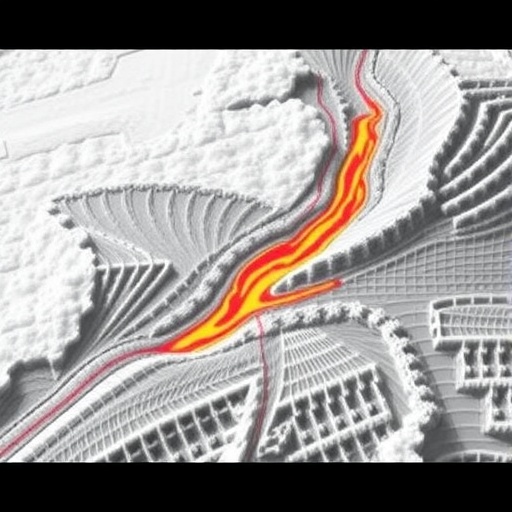In a groundbreaking study aimed at unravelling the complexities of seismic activity, a team of esteemed researchers led by Tom Muzellec has explored the fault zone damage incurred during the significant Northern Nagano earthquake of 2014. This catastrophic event provides a unique opportunity to investigate the mechanisms of fault rupture and the structural impacts that follow such seismic events. By examining the aftermath of this earthquake, the research team aims to enhance our understanding of fault dynamics and provide insights that could potentially lead to improved earthquake preparedness and risk mitigation strategies.
The Northern Nagano earthquake, which struck on November 22, 2014, with a magnitude of 6.7, caused extensive damage across the region. Buildings were reduced to rubble, roadways cracked, and lives were disrupted. However, it is the unseen damage within the earth’s crust that has drawn the attention of scientists. Fault zones are complex systems where geological stress accumulates until it is released in a sudden rupture, and understanding the nature of these zones is critical for developing models that predict future seismic activity.
In their research, Muzellec, alongside co-authors Giovanni De Landro and Andrea Zollo, meticulously analysed the fault rupture dynamics associated with the mainshock of the Northern Nagano earthquake. They employed a combination of field observations and advanced geophysical imaging techniques, allowing them to visualize the fault structure and identify how the rupture propagated through the geological materials. This innovative approach enables researchers to reconstruct the event and quantify the extent of damage to the fault zone itself.
The team documented varying degrees of fault zone deformation, which, interestingly, did not adhere to previously established theories about fault rupture mechanics. In some areas, the stress release was more significant than anticipated, suggesting that the energy transfer during the rupture had profound effects on the surrounding geological materials. This observation highlights the complexity of fault interactions and indicates that the process is far from uniform across different segments of a fault line.
One of the critical findings of the study was the identification of secondary faulting that occurred as a direct consequence of the primary rupture. These secondary faults can potentially become sources of future seismic activity, complicating the regional seismic hazard assessment. The study underscores the importance of considering these secondary fractures when evaluating the risks associated with fault systems and provides a new perspective on how aftershocks might be generated in the wake of a major earthquake.
Additionally, the research delves into the lasting effects of the 2014 earthquake on the physical landscape of Northern Nagano. The team observed shifts in ground elevation and changes in the hydrology of the area, both of which have implications for ecosystems and human infrastructure. These findings serve as a poignant reminder of the interconnectedness of geological events and their impact on the environment and society.
Another significant aspect of the study pertains to the role of geological conditions in influencing the behavior of fault ruptures. The researchers noted that variations in rock type and fluid pressure within the fault zone significantly affect rupture propagation and fault slip behavior. Their observations reveal that understanding the local geological context is critical for early-warning systems and can aid in developing localized earthquake response strategies.
However, despite these advances, feedback from the scientific community highlights that there is still much to learn about the intricate processes governing fault mechanics. The interactions within fault zones remain one of the most enigmatic aspects of geophysics, and researchers continue to grapple with the challenge of predicting seismic events based on historical data.
As the research community continues to explore these unsolved mysteries, the implications of Muzellec and his colleagues’ findings cannot be overstated. Their work emphasizes the need for sustained investment in geological research and monitoring networks, especially in earthquake-prone regions. The knowledge derived from such studies can ultimately inform policies and practices aimed at reducing the devastating impacts of future earthquakes.
In conclusion, the analysis of fault zone damage resulting from the mainshock of the Northern Nagano earthquake represents a significant advance in our understanding of seismic dynamics. By shedding light on the complex interactions that occur during and after an earthquake, this research serves as a testament to the importance of scientific inquiry in addressing natural hazards. Continued exploration of these processes is essential for developing effective response strategies that can save lives and mitigate the economic impact of seismic events.
As we reflect on the insights gained from this study, it becomes clear that the science of earthquakes is not just a pursuit of knowledge; it is a vital endeavor that holds the key to safeguarding communities against the unpredictable nature of our planet. The findings from this research push the boundaries of what is known about fault dynamics and pave the way for future investigations that can help demystify the riddle of earthquakes.
Subject of Research: Fault zone dynamics and damage assessment from the Northern Nagano earthquake.
Article Title: Fault zone damage caused by the mainshock rupture during the 2014 Northern Nagano earthquake.
Article References:
Muzellec, T., De Landro, G. & Zollo, A. Fault zone damage caused by the mainshock rupture during the 2014 Northern Nagano earthquake.
Commun Earth Environ 6, 934 (2025). https://doi.org/10.1038/s43247-025-02890-1
Image Credits: AI Generated
DOI: https://doi.org/10.1038/s43247-025-02890-1
Keywords: Fault rupture, seismic dynamics, Northern Nagano earthquake, geological research, aftershocks, risk mitigation.




